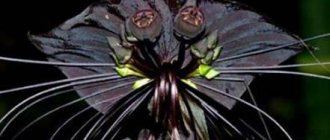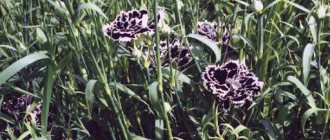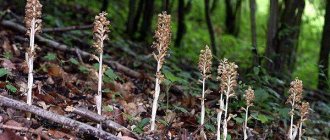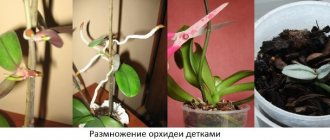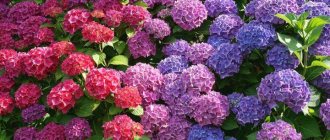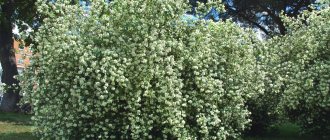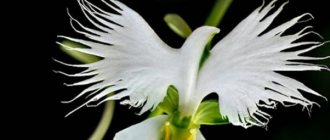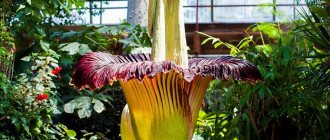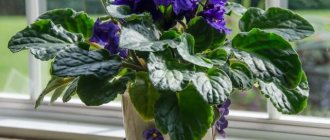“Cornflower, cornflower...My favorite flower”... The words of this famous children's song are familiar to almost everyone, however, the plant, which is striking in its rich bluish-blue color and has healing properties, is rarely included in the list of the most beautiful. And in vain. After all, this flower is translated from the Old Russian language as “royal” - a symbol of courtesy, purity and friendliness. Many legends are associated with the appearance of this flower, from one of which we learn about the healing properties of cornflowers: when the centaur Chiron entered into a fierce battle with Hercules, he received deep wounds - it was the juice of cornflowers that helped heal them.
The beauty of these blue-azure flowers is also associated with their beneficial properties: cornflower flowers are used in pharmacology and folk medicine; for its beauty and brightness of color, it is considered the best flower for wreaths and bouquets; it is often used in cosmetology and perfumery, as well as in dyeing wool fabrics and making ink. It is also interesting that this plant is the national flower of Estonia, however, in some European countries it is known as the “German flower”, and for the Russian fabulist Ivan Krylov this flower became fateful - thanks to it he recovered from a serious illness and was awarded the highest attention of Empress Maria Feodorovna. Today we invite you to learn about the most beautiful cornflowers in the world.
Cornflower blue
“Blue centaur flower,” as the name of this plant is literally translated, we rarely see in flower beds or meadows: its habitat is wide and endless fields, where wheat and rye grow nearby. Blue cornflowers, also called “royal potion,” are the most famous species today.
Flowers of soft blue, azure-turquoise and deep blue, stems up to 80 cm high, unpretentiousness and frost resistance - this is what sets them apart from other species. In addition, these flowers are drought-resistant and love the sun very much, which is perhaps why their shades are unusually diverse, because these flowers always turn different sides towards the sun.
Types of the most beautiful cornflowers
The genus of these flowers includes up to 500 species (both annual and perennial), which decorate fields, meadows and gardens from early summer until September. In addition to the beautiful flowers with the characteristic blue color of the petals, there are also those that impress with white, yellow, purple and pink blooms.
Blue or field cornflowers
Greek myths say that these flowers healed the wise Chiron from the hydra bite. That is why cornflowers are called the “blue flower of the centaur.” These annual plants with characteristic turquoise inflorescences are one of the most beautiful representatives of the cornflower genus. But in agriculture, bright blue flowers in rye fields are considered weeds and are destroyed.
The length of the stem of field cornflowers can reach up to 80 cm. There are annual and perennial varieties, the turquoise colors of which create the illusion of the sky falling on fields, meadows and wastelands. Due to the characteristic color of the petals, field cornflowers are called blue flowers or hairs. These flowers were especially popular among the ancient Egyptians, who widely used the image of cornflowers when creating jewelry. Even in the tomb of Tutankhamun, the pharaoh’s funeral wreath of “blue flowers” was found.
Mountain cornflowers
These flowers can grow in the most difficult conditions, on almost any soil. They are found in the vast expanses of Central Asia and Western Europe. They can bloom in the usual blue color or have unusual purple and burgundy colors.
The colorful blooms of these cornflowers can be observed from late May to August.
White cornflowers
Many people associate cornflowers exclusively with the blue of the sky. But there are exceptions that are no less captivating with their extraordinary beauty. White cornflower is like an albino in a family of colorful brothers. This is a very rare species, which even ended up on the pages of the Red Book. The plant is also small in size - the stem of white cornflowers rarely exceeds 30 cm.
Large-headed cornflowers
These perennial plants impress with their longest stem (up to 1 m) and large flowers (up to 7 cm in diameter) of light or bright yellow color. The homeland of the species is the expanses of Transcaucasia. In gardens, such flowers are planted in flower beds in the background to create a beautiful background for other tall plants. These beautiful cornflowers bloom in mid-July and delight with their colorful blooms for 1.5 months.
Meadow cornflowers
This species is a true decoration of meadows and forest glades. In Slavic mythology, its appearance is associated with the anger of a mermaid, who turned a guy named Vasily, who refused her love, into a beautiful meadow flower. These plants are perennial, and their stem height reaches up to 80 cm. Meadow cornflowers impress with their unusual pink or purple color, and their flowers are collected in baskets.
Fisher's cornflower
This flower is endemic to the Caucasus, and in the wild it is found exclusively in the vast alpine meadows of this region. Its stems can reach up to 50 cm, and the flowers have a wide variety of colors. The inflorescences can be light pink, with a lilac or lemon tint and stand out beautifully among the alpine forbs.
Whitened cornflower
Due to the heterogeneity of color, this type of cornflower is considered one of the most beautiful among its “relatives”. Its flowers are bright pink, and its pinnately dissected leaves, which are white below and green above, give a special decorative appeal. The height of the plant can reach 60 cm. Its native growing areas are the mountains of the Caucasus and Northern Iran.
Pink cornflowers
These perennial plants up to 1 m in height fascinate with large single inflorescences of soft pink color.
It is this type of cornflower that is most often grown in gardens. Flowers delight with their colorful blooms from mid-summer.
Russian cornflower
These flowers with light yellow inflorescences decorate the steppe expanses of Russia and Kazakhstan in the summer. The bare stems of the plant can grow up to 50-140 cm. Growing in the wild in difficult conditions, this type of cornflower can withstand drought and is resistant to cold. In gardens, it most often plays the role of background in mixed flower beds.
Musk cornflower
A close relative of the blue cornflower, it is slightly shorter and slimmer, adding to its graceful beauty. Originating from South-Eastern Europe, this flower is distinguished by a color unusual for cornflowers - purple-white or yellow. Characterized by their “fluffiness” and special “terry” quality, cornflowers are especially valuable for florists, since their stems are smooth and their flowers are lush, which allows them to be combined into original compositions.
This amberboa flower (second name) can also be recognized by its special pleasant aroma, called “amber” in Arab countries. Let us note that the aroma of such cornflowers is much stronger than that of its relatives, so if you find yourself in a field of musk cornflowers, you will certainly feel, as people say, “the smell of summer.”
American cornflower
This type of cornflowers, unlike the previous one, is quite strong and large. The height of the stem reaches 1 meter, and it itself is hard and abundantly leafy. The stems of this flower are slightly pointed, the flowers are in the form of terry baskets of white, lilac or pinkish-violet color. This type of cornflower is often used in decoration for its beauty and is also planted in botanical gardens.
Growing rules
Where do cornflowers grow, in what conditions? The plant is cold-resistant, light-loving and unpretentious to care. It easily tolerates light partial shade. Different soils are suitable, but not soggy.
One of the basic rules for growing cornflowers in open ground is timely fertilizing with fertilizers. They are necessary for good and abundant flowering. To do this, you can prepare the following solution: nitrophoska and urea (one tablespoon each) are diluted in 10 liters of water.
Fertilizers are applied before flowering in an amount of about 4 liters per 1 square meter. Spraying with Zircon before budding is good for accelerating flowering (1 ml of the drug per 1 liter of water). Consumption - one liter of solution per 30 square meters. m.
Imperial cornflower
Graceful flowers of variegated shades rightfully occupy a place in our selection, since they demonstrate their beauty longer than their relatives. Such cornflowers, as a rule, reach a height of 50–80 cm, and bloom in sunny meadows, lawns and plantings for about 45 days. Interestingly, this species remains fresh for a long time even after cutting, emitting a subtle, pleasant aroma. This culture is also unpretentious, which is why it is very popular among gardeners.
Garden forms
Thanks to the work of breeders, many new garden forms with different colors have appeared: pink, white, dark blue, purple. There are also cornflowers with an unusual short stem (20-25 cm).
The most popular varieties:
- Mountain cornflower, perennial. Blooms profusely with blue feathery flowers in May and June. Height – up to 70 cm. Used for group plantings. Rejuvenation is carried out by dividing the bush every 3-4 years.
- Cornflower “Mixed Colors” is the most popular annual. Inflorescences are blue, white, pink. Height – 40-80 cm.
Tall varieties are good for cutting (they last a long time in water), low ones - for flower beds and ridges.
Whitened cornflower
This type of flower is characterized by perennial flowering and is the most elegant subspecies. Matte pink, deeply fringed flowers and dark green leaves with silver threads form lush hemispherical bushes and usually bloom in late July. But such beauty requires care, so these cornflowers require good garden soil, constant sunlight and moderate moisture.
White cornflower
It is not difficult to guess the color scheme of one of the most beautiful varieties of cornflowers, since its name speaks for itself. Indeed, the white basket inflorescences are unusually attractive and delicate. Their height does not exceed 25 cm, and the diameter of the flower is 4 cm. They are quite rare, therefore they are listed in the European Red Book.
Eastern cornflower
This herbaceous perennial stands out among others with bright yellow flowers. Having appeared in western Transcaucasia, the plant began to grow on rocky slopes and mountain paths, as a result of which light sandy soil became the best soil for growth. Some people confuse it with thistle, however, we note that this cornflower has different stems and leaves. Not everyone can observe the beauty of the oriental species, which is why it is already included in the Red Book of Russia, and has a special status in the Belgorod, Kursk and Volgograd regions.
Benefits of cornflower flowers
Russia is a country where cornflowers grow almost everywhere. Many people collect them to dry them and use them for medicinal purposes when necessary.
The marginal flowers of blue cornflower are a wonderful diuretic. They are effective for nephritis, urethritis, cystitis. They are also used as a mild choleretic agent for diseases of the biliary tract and liver.
In addition, the flowers of the plant have diaphoretic, antimicrobial, anti-inflammatory and tonic effects. This is due to the plant containing a large amount of biologically active substances, especially flavonoids, anthocyanins, glycosides, alkaloids, as well as mineral salts and vitamins.
Mountain cornflower
This plant is one of the favorite and most recognizable, as it often decorates flower beds, rockeries and edges near paths and paths. Planted, as a rule, on the south side, mountain cornflower prefers uniform, not too scorching sunlight, so when planting it, you should carefully study the area. Its beauty is attractive not only to people, but also to insects and birds, who happily flock to the fragrant aroma and bright flowers of cornflowers.
Application of Cornflower:
The cornflower flower is used in cooking. Its leaves have a delicate aroma and are often used as a seasoning for dishes.
Medicine has not been spared cornflowers either. This flower has diuretic properties. Therefore, cornflower decoctions are used for kidney diseases, edema, etc. Cornflower decoctions also have choleretic properties. It is also used for liver diseases, including jaundice. Cornflower also has antipyretic, diaphoretic and bactericidal properties.
The flower is often used in cosmetics. Cornflower is also in demand as a decorative flower. Cornflower is also mentioned as a dye for Easter eggs. But in our time, when food dyes are available, it is unlikely that people will run into the field for cornflowers.
yellow cornflower
A tall flower with bright yellow spherical inflorescences is distinguished by large flowers, which is why it is also called “large-headed”. The tallest (up to 120 cm) stem allows these flowers to rise above others, which attracts insects and butterflies. An interesting fact is that when the buds are cut, the stems and leaves of the yellow cornflower will remain green until cold weather, so it is not only the largest of the cornflower genus, but also the most durable flower.
Spreading cornflower
The beauty of this species lies not in the shape of the flower or the rich color, but in the number of buds and their unusually delicate, almost transparent shades. Popularly referred to as harlay, camel, perecatipole, splay or gill, this dry-resistant flower is an excellent honey plant, therefore it often acts as a lifesaver for beekeepers in dry years.
Planting and caring for summer color cornflower
Summer paint cornflower is an artificially bred species that is used mainly for decorative purposes. In comparison with ordinary types, it can have not only standard, cold colors, but also brighter ones. In general, plants of this species have one of the smallest heights among all representatives of the cornflower species.
Before planting, read the instructions on the back of the seed package. Before planting, prepare all the necessary garden tools and improve the soil before sowing. Please note that the seeds are sown directly into the ground, without the use of seedlings. The distance between seed holes should be at least half a meter to all adjacent holes.
One of the propagation options occurs by dividing an adult plant into “divisions” and growing them directly.
Cornflower seeds are sown at the end of April, and division by dividing an adult plant occurs in mid-to-late August. Seeds will grow effectively if they are less than three years old, otherwise the chance of successful germination is sharply reduced.
The plants are not whimsical, and they only need watering and loosening the soil for better access of oxygen to the roots. Flowering when planted in April will occur in June-July.
Pink cornflower
The harmonious combination of all shades of pink sets this subspecies apart from others. Delicate inflorescences are usually dark in the center and almost white at the edges. These cornflowers, like others, are not demanding and grow on almost any soil, however, we note that the pink cornflower is capricious and gets used to the planting site very quickly. It happens that it takes root in a flowerbed only in the area that was first planted and rarely goes beyond it.
meadow cornflower
Lilac-pink flowers leave no one indifferent, especially since everyone can see this species. Growing along roads, in mixed forests, meadows and fields, cornflower reaches a height of about 50 cm, and its inflorescences are about 3 cm. Although it is classified as a weed, we can say that its sometimes “killer” beauty is so pleasing to the eye that For a moment you can forget about the harm the plant causes to the soil and crops and just enjoy the view of one of the most beautiful cornflowers.
What you need to know to plant cornflowers
Of course, to create a chic garden, you need not only to know how to spell cornflowers or cornflowers, but also to learn certain planting rules. Fortunately, they are light enough that even a child can handle them, not to mention a more or less experienced gardener.
How to choose the optimal location
Tradescantia ampelous flower: what kind of flower is it
It all starts with choosing a suitable location. If you don’t make mistakes here, the flowers will grow without causing unnecessary problems. Conversely, if you plant in an area with unsuitable conditions, you can spend a lot of time and effort, but not achieve the desired result.
The best place would be a flat area that is illuminated from morning to evening - the plant is not afraid of excessive heat with sufficient moisture. To increase their decorative value, it is advisable to plant cornflowers next to low-growing flowers or shrubs - they will look simply excellent.
Interesting ! The flower received recognition not only from flower growers, but also from artists - the desire to paint it was expressed by Bilibin, Levitan, Gribar and many other famous artists.
Step by step planting process
The easiest way to get beautiful flowers in your garden is to use seeds. The planting process is best carried out in late September or early August.
The planting scheme depends on whether the gardener uses large or small varieties. It can vary from 10x10 to 20x20 cm. So, it will be useful to know in advance how compact the plant is planted - this will avoid serious problems in the future.
- The earth is loosened in advance, at the same time making shallow holes - about 1.5 cm.
- The seeds are simply laid out in the prepared holes.
- Then they cover themselves with earth.
- Water abundantly - of course, only if there was not heavy rain shortly before, which well moistened the soil.
There is also an alternative method of planting - cuttings and roots. But it is used only when working with perennial species and is completely unsuitable for annual species. A serious advantage of this solution is the fact that the transplanted plant exactly retains all the features inherent in the mother plant.
Cornflower seeds
